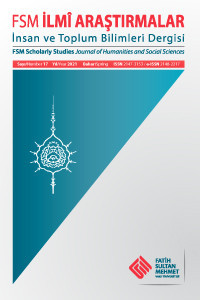Türk Edebiyatı Tarihi Çalışmalarında Hiyerarşik (Piramidal) Mekân Sorunu
Çalışmamızda edebiyat tarihi yazımında izlenen veya izlendiği düşünülen stratejiler
aracılığıyla oluşan hiyerarşik (piramidal) mekân sorununa dikkat çekmek ve bu sorunun
edebiyat tarihinin inşası ve algılanışındaki etkisine odaklanmak istiyoruz. Genel olarak
edebiyat tarihlerindeki değerlendirmelerde, yazarın (tarihçinin) ideolojisine uygun düşen
isimlerin daha üstte, yazarın ideolojisinden farklı noktada verimleri/metinleri, düşünceleri
olanların daha altta değerlendirildiği dikkatimizi çekmektedir. Bu dizilişe cinsiyet merkezli
baktığımızda ise büyük oranda, erkek edebiyatçıların daha çok merkezî mekânda,
piramidin üst tepe noktasında, kadın edebiyatçıların ise büyük oranda marjinal mekânda
yani dipte konumlandırıldığı piramidal diziliş öne çıkmaktadır.
Bu piramidal mekânın en büyük karakteristiği; erkek edebiyatçılar ve metinleri değerlendirilirken
sanat ve edebiyat alanından kavramlar, terimler, benzetmeler kullanılırken,
kadın edebiyatçılar ve metinleri için farklı alanlardan, özellikle psikolojiden ödünç
alınan kavram ve ifadelerin kullanılması, kadın edebiyatçıların cinsiyetlerinin, kadın
oluşlarının vurgulanması, genellikle kadın konusundan bahsettiklerinin öne sürülmesi
ve ‘kadınca yazdıkları’nın iddia edilmesidir. Erkek edebiyatçılar için ayrıca gerek
duyulmayan cinsiyete ilişkin bu hassasiyet, yazarın edebî üretimlerinden çok cinsiyetine
odaklanılan bir bakış açısının sonucu gibi görünmektedir. Piramidal dizilişin beden üzerindeki
tezahüründe, tepe noktasının yani aklın erkekle, tabanın yani duygunun kadınla
özdeşleşmesine ilişkin bilinç dışı çağrışımların izlerini de görmek mümkündür. Bu çalışmada bizatihi edebiyat tarihi kurgulanırken kullanılan, kullanılagelen kavramların,
benzetmelerin, sıfatların, yargıların, kelimelerin kendi içinde hiyerarşi oluşturduğunu,
bütün normların hiyerarşik (piramidal) mekân düzlemini kurduğunu ve
işlettiğini, farklı edebiyat tarihlerinde kadın edebiyatçılar ve metinleri için yer alan değerlendirmelerden
yola çıkarak örneklere göstermeye çalışacağız.
The Problem of Hierarchical (Pyramidal) Space in the Turkish Literature History Studies
In this study, we aim to draw attention to the hierarchical (pyramidal) space issue,
which is formed through the methods followed or thought to be followed in literary historiography,
and to focus on the effect of this issue on the construction and perception of
literary history. In general, in the evaluations of literary histories, it draws our attention
that the names corresponding to the author’s (historian’s) ideology are evaluated at the
top, and those whose texts and thoughts are different from the author’s ideology are considered
as unimportant. When we look at this array based on gender, it can be observed
that male writers are mostly positioned in the central space, at the top of the pyramid, and
female writers are mostly positioned in the marginal space, that is, at the bottom.
The biggest characteristic of this pyramidal space is the use of concepts, terms and
similes from the field of art and literature when evaluating male writers and their texts,
and the use of concepts and expressions borrowed from different fields, especially psychiatry,
for female writers and their texts. In the histories of literature, there is an emphasis
on the genders of women writers and it is claimed that they mostly talk about women in
their works. This sensitivity to gender, which is not needed for male writers, seems to be
the result of focusing on the gender of the writer rather than her literary productions. In
this pyramidal arrangement, the mind at the top is identified with the man, and the base of
the pyramid, namely sexuality, with the woman.
In this study, we claim that the concepts, similes, adjectives, norms, judgments, words
that are used while constructing the history of literature itself form a hierarchy within
themselves. We will try to show examples that all these uses establish and operate the
hierarchical (pyramidal) space, starting from the evaluations of women writers and their
texts in different literary histories.
